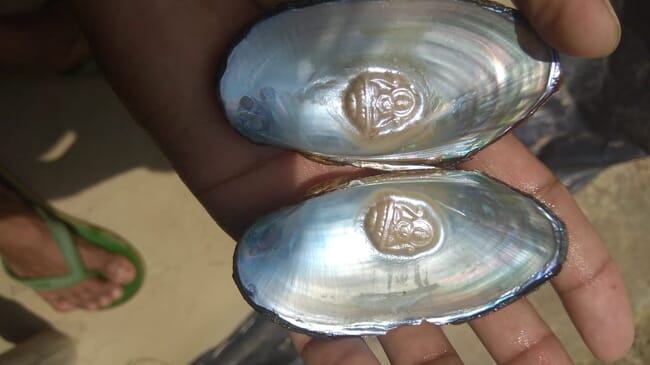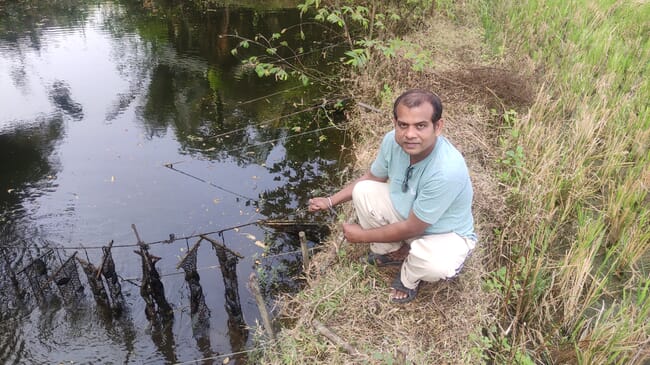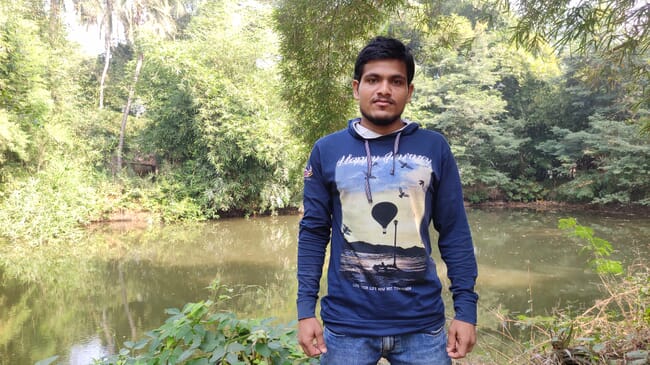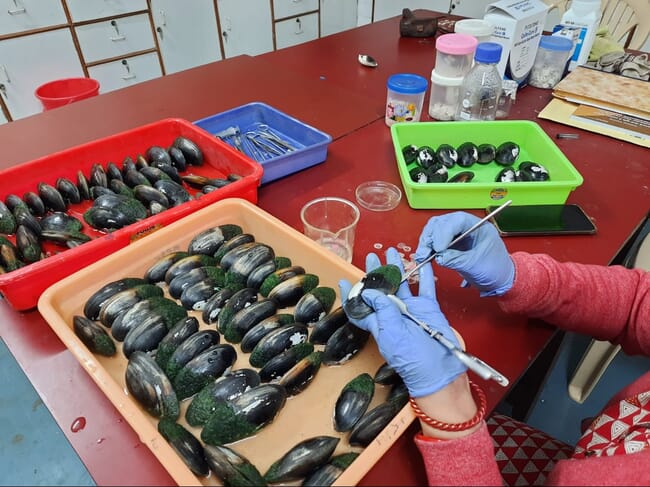
© ICAR CIFA
Bibhuti Bhusan Mohanty had been working in Dubai for the past two years. The 25-year-old engineer had planned to settle abroad before the lockdown forced him to change his plans.
Mohanty returned to his village in Nimigan, in Odisha’s Ganjam district, in early 2020. Unable to find a job, he was fiddling with his mobile phone one day when he came across a video of people in his area farming freshwater pearls.
“I became inquisitive about it as soon as I saw the video. I then searched on the internet to get more info about pearl culture. It was really surprising to see how pearl farming was offering lucrative livelihoods to farmers in our state,” he says.
He then contacted the ICAR-Central Institute of Freshwater Aquaculture (CIFA), an advanced research institute, who then connected him with a local farmer for guidance.

© Gurvinder Singh
Bibhuti undertook a training programme and then stocked around 3,000 freshwater pearl mussels (Lamellidens marginalis) in his pond.
It will take another year before the mussels create pearls for him but he has dropped his plans of emigrating and has decided to settle in his village to farm pearls.
“It’s useless to waste time abroad, or even in other cities of India, when a handsome income can be made in your native village,” he says.
Many ponds that have been used for cultivating Indian major carp are suitable for producing pearls. Rectangular ponds without aquatic macrophytes and algal blooms such as Microcystis and Euglena are suitable for pearl culture. Two half-acre earthen ponds or a single pond of 1 acre, with a depth of 1-2.5m, is suitable for farming the mussels. As a result, it is no surprise that Bibhuti is not alone. Several hundred people who have returned to Odisha during the pandemic have shed their plans to emigrate in favour of doing something potentially lucrative – such as pearl farming – in their native villages.

© Gurvinder Singh
However, those interested are advised to take a number of factors into account before starting. A pH in the range of 7 to 8 is favourable because pearl mussels require more calcium for the secretion of nacre. Water temperature is also an important factor in the mussels’ growth and reproduction, and the process of pearl formation in mussels’ body cavities requires a temperature in the range of 25-30°C.
Farmers should know the biology and food requirements of the mussels. Careful pond management is needed, particularly in terms of natural food production, and the water must be disease free. The management of water quality, through liming or fertilisation, is particularly important during the culture period, as it affects the quality and quantity of the pearls. There should also be algal culture facilities in the mussel farm. The hanging bags which contain the implanted mussels should be cleaned fortnightly and any dead mussels should be immediately removed.
Surging interest
Scientists at ICAR-CIFA say that they have been flooded with calls from people interested in starting pearl farming since lockdown was imposed.
“The concept of pearl farming is nothing new. It has been there for the past two decades. But people hardly took any interest and we used to receive fewer queries. But the pandemic changed everything. Since March, when the lockdown was announced in India, our phones have not stopped buzzing. We are receiving around 20 to 30 calls every day, whereas it was just three to four calls prior to the lockdown,” says Dr Saroj Kumar Swain, director of ICAR-CIFA in Bhubaneswar, the state capital of Odisha.
He also believes that social media has been playing a major role in spreading awareness of pearl culture, especially among the younger generation.
“Earlier, we used to provide physical training, where a batch of only 20 people could be accommodated, but it was stopped during lockdown. We then decided to make short videos on pearl farming and uploaded them on YouTube. It proved to be a game-changer and they started getting massive viewership. On an average, each video began to garner around 30,000 views and even higher,” he adds.
“We also started conducting virtual classes in September and have now trained around 3,700 people on pearl culture from across the country. The videos also come in handy to explain about releasing mussels in freshwater ponds and maintaining them.”
Creating the pearl
The pearl mussels are generally caught from freshwater bodies and a small surgical insertion is then made, in order to implant a nucleus inside the mussel, around which a pearl is created.
“A small surgery is done to insert round nucleus or irritant inside the gonad together with a piece of mantle. When inside the body of a living mussel, the piece of mantle merges with the wall of the gonad through a connective tissue. They are carefully opened by the means of speculum of around 1cm wide, without causing injury to the adductor muscle and its soft parts,” says Sweta Pradhan, a scientist working in pearl culture at ICAR-CIFA.
“After implantation, the mussels are kept in post-operative care units that are normally ferro-cement tanks (200 litres) filled with aged tap water and 50 nylon bags (12cm2) arranged in two rows, suspended at a depth of 20cm. The units are daily examined and the dead mussels and the ones that reject the nucleus are removed. After post-operative care these mussels are stocked in the ponds. It normally takes a year before the mussel creates a pearl.”
Some farmers have become so advanced and knowledgeable in pearl culture that they make the surgical insertions by themselves and also offer consultancy to other farmers.
Akshay Pradhan, who lives at Dimbiria village in Ganjam district, does pearl culture in his own pond and also acts as a consultant for other budding farmers.
“The farmers contact me for surgical implants regularly. I also provide consultancy to them regarding the pearls and releasing them in ponds,” he says.

A small surgical insertion is made to implant a nucleus inside the mussel, around which a pearl is created © ICAR CIFA
The 41-year-old, who started pearl farming around a decade ago, claims to have been earning around Rs 4 lakh (around US$5,400) annually by making round and designer pearls. He travels across the country to sell pearls to dealers, which are then normally used in ornaments. Akshay says that he will soon dispatch a consignment of pearls to Iraq.
However, he points out that pearl culture isn’t without its challenges.
“Most of people jump into pearl culture considering it to be a lucrative profession, but they fail to follow the proper regimes like providing food (such as plankton) and changing the water, which is required only in the case of tanks to maintain the pH and ammonia levels. Carelessness in following these practices often results in severe losses. Some even try to do surgical implants themselves, which results in severe mortality initially, but it comes with experience and regular practice.”
Dr Swain points out that ICAR-CIFA is now focusing on promoting captive breeding of the mussels.
“At present, the mussels are caught from natural water bodies and sold to farmers. But the supply still falls short of the huge demand. We are trying to promote captive breeding to increase the supply,” he says.



